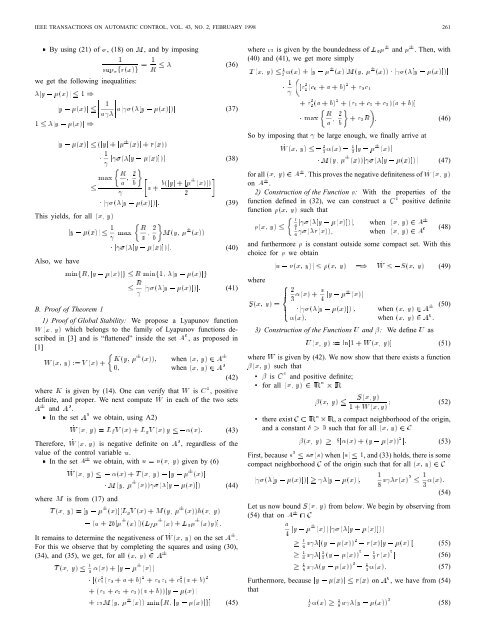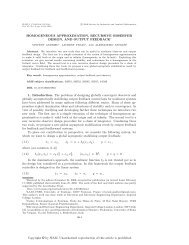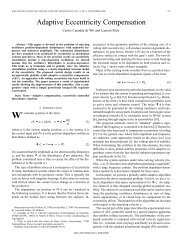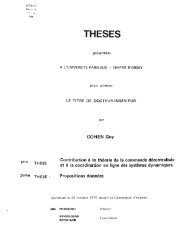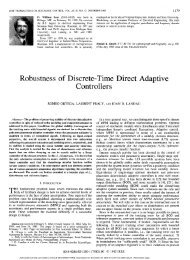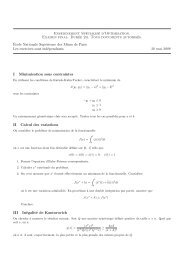Integrator Backstepping For Bounded Controls And Control Rates ...
Integrator Backstepping For Bounded Controls And Control Rates ...
Integrator Backstepping For Bounded Controls And Control Rates ...
Create successful ePaper yourself
Turn your PDF publications into a flip-book with our unique Google optimized e-Paper software.
IEEE TRANSACTIONS ON AUTOMATIC CONTROL, VOL. 43, NO. 2, FEBRUARY 1998 261<br />
By using (21) of , (18) on M, and by imposing<br />
1<br />
sup x<br />
fr(x)g = 1 R (36)<br />
we get the following inequalities:<br />
jy 0 (x)j 1)<br />
jy0(x)j 1 aj([y 0 (x)])j (37)<br />
a<br />
1 jy 0 (x)j )<br />
jy0(x)j(jyj+j 6 (x)j+r(x))<br />
1 1 j([y 0 (x)])j (38)<br />
<br />
max<br />
<br />
R a ; 2 b<br />
<br />
a + b(jyj + j6 (x)j)<br />
2<br />
1j([y 0 (x)])j: (39)<br />
This yields, for all (x; y)<br />
jy 0 (x)j 1 max R<br />
a ; 2 M (y; 6 (x))<br />
b<br />
1j([y 0 (x)])j: (40)<br />
Also, we have<br />
minfR; jy 0 (x)jg R minf1; jy0(x)jg<br />
R j([y 0 (x)])j: (41)<br />
<br />
B. Proof of Theorem 1<br />
1) Proof of Global Stability: We propose a Lyapunov function<br />
W (x; y) which belongs to the family of Lyapunov functions described<br />
in [3] and is “flattened” inside the set A 0 , as proposed in<br />
[1]<br />
W (x; y) :=V(x)+ K(y; 6 (x)); when (x; y) 2 A 6<br />
0; when (x; y) 2 A 0 (42)<br />
where K is given by (14). One can verify that W is C 1 , positive<br />
definite, and proper. We next compute W _ in each of the two sets<br />
A 6 and A 0 .<br />
In the set A 0 we obtain, using A2)<br />
_W (x; y) =L f V(x)+L g V(x)y0(x): (43)<br />
Therefore, _W (x; y) is negative definite on A 0 , regardless of the<br />
value of the control variable u.<br />
In the set A 6 we obtain, with u = (x; y) given by (6)<br />
_W (x; y) 0(x)+T(x; y) 0 [y 0 6 (x)]<br />
1 M (y; 6 (x))([y 0 (x)]) (44)<br />
where M is from (17) and<br />
T (x; y) =[y0 6 (x)][L g V (x) +M(y; 6 (x))h(x; y)<br />
0 (a +2bj 6 (x)j)(L f 6 (x) +L g 6 (x)y)]:<br />
It remains to determine the negativeness of _W (x; y) on the set A 6 .<br />
<strong>For</strong> this we observe that by completing the squares and using (30),<br />
(34), and (35), we get, for all (x; y) 2 A 6<br />
T (x; y) 1 3 (x) +jy06 (x)j<br />
1[(c 2 1(c 0 + a + b) 2 + c 0 c 1 + c 2 2(a + b) 2<br />
+(c 1 +c 2 +c 3)(a + b))jy 0 (x)j<br />
+ c 2 M (y; 6 (x)) minfR; jy 0 (x)jg] (45)<br />
where c 3 is given by the boundedness of L g 6 and 6 . Then, with<br />
(40) and (41), we get more simply<br />
T (x; y) 1 3 (x) +jy06 (x)jM(y; 6 (x)) 1j([y 0 (x)])j<br />
1 1 <br />
[c 2 1(c 0 + a + b) 2 + c 0 c 1<br />
+ c 2 2(a + b) 2 +(c 1 +c 2 +c 3 )(a + b)]<br />
1 max R a ; 2 + c 2R : (46)<br />
b<br />
So by imposing that be large enough, we finally arrive at<br />
_W (x; y) 0 2 (x)0 1jy06 (x)j<br />
3 2<br />
1M(y; 6 (x))j([y 0 (x)])j (47)<br />
for all (x; y) 2 A 6 . This proves the negative definiteness of W _ (x; y)<br />
on A 6 .<br />
2) Construction of the Function : With the properties of the<br />
function defined in (32), we can construct a C 1 positive definite<br />
function (x; y) such that<br />
(x; y) 1 j([y 0 (x)])j; when (x; y) 2 A6<br />
4<br />
1<br />
4 (r(x)); when (x; y) 2 (48)<br />
A0<br />
and furthermore is constant outside some compact set. With this<br />
choice for we obtain<br />
where<br />
S(x; y) =<br />
ju 0 (x; y)j (x; y) =) _ W 0S(x; y) (49)<br />
2<br />
3 (x)+ a jy06 (x)j<br />
4<br />
1j([y 0 (x)])j; when (x; y) 2 A 6 (50)<br />
(x); when (x; y) 2 A 0 .<br />
3) Construction of the Functions U and : We define U as<br />
U (x; y) := ln[1 + W (x; y)] (51)<br />
where W is given by (42). We now show that there exists a function<br />
(x; y) such that<br />
• is C 1 and positive definite;<br />
• for all (x; y) 2 IR n 2 IR<br />
S(x; y)<br />
(x; y) <br />
1+W(x; y) ; (52)<br />
• there exist CIR n 2 IR, a compact neighborhood of the origin,<br />
and a constant >0such that for all (x; y) 2C<br />
(x; y) [(x) +(y0(x)) 2 ]: (53)<br />
First, because s 2 s(s) when jsj 1, and (33) holds, there is some<br />
compact neighborhood C of the origin such that for all (x; y) 2C<br />
j([y 0 (x)])j jy 0 (x)j;<br />
1<br />
8 ar(x)2 1 3 (x):<br />
(54)<br />
Let us now bound S(x; y) from below. We begin by observing from<br />
(54) that on A 6 \C<br />
a<br />
4 jy06 (x)jj([y 0 (x)])j<br />
1 4 a[(y 0 (x))2 0 r(x)jy 0 (x)j] (55)<br />
1 4 a[ 1 2 (y 0 (x))2 0 1 2 r(x)2 ] (56)<br />
1 8 a(y 0 (x))2 0 1 3 (x): (57)<br />
Furthermore, because jy 0 (x)j r(x)on A 0 , we have from (54)<br />
that<br />
1<br />
3 (x) 1 8 a(y 0 (x))2 (58)


